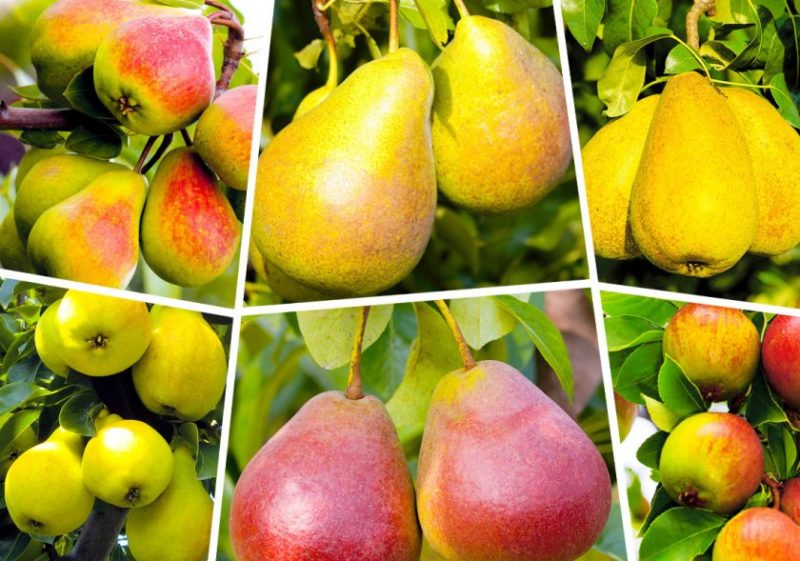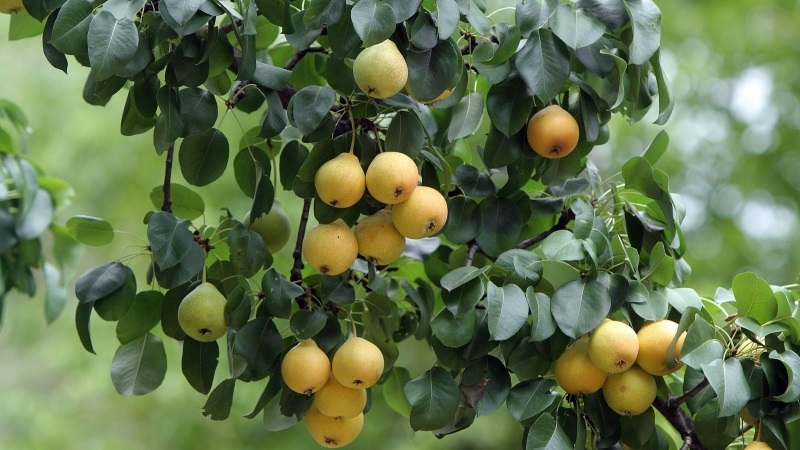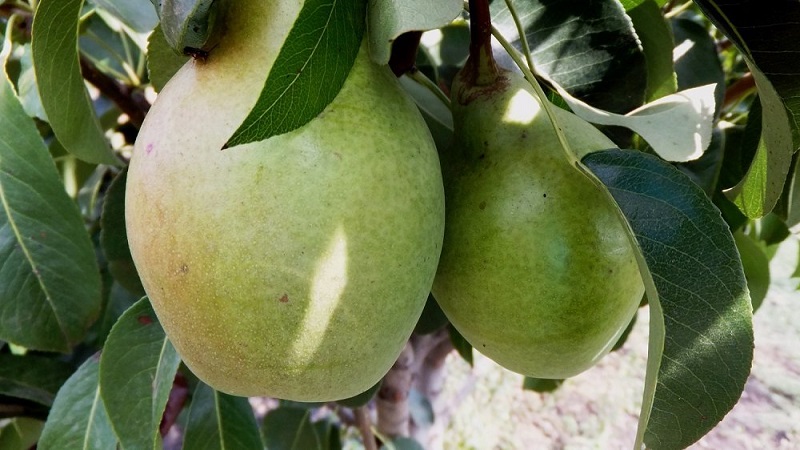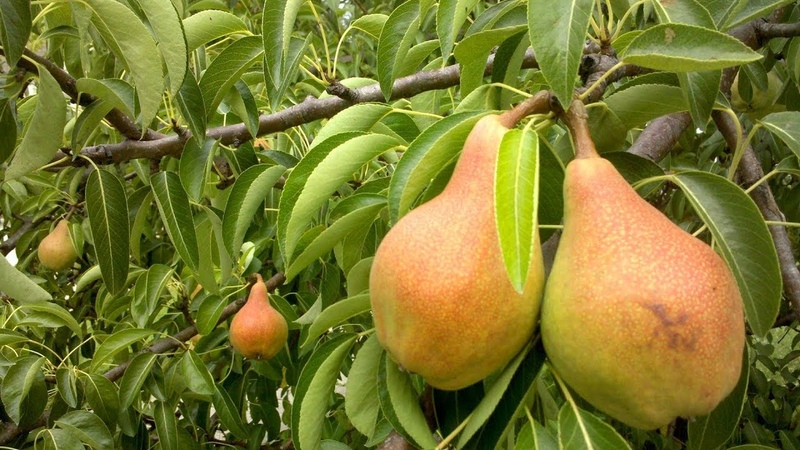List of the best pear varieties for central Russia
There are pear trees in every summer cottage. Some gardeners prefer to grow early varieties, which are harvested in July, while others plant late-ripening varieties that bear fruit until early October. Along with other garden trees, the pear is unpretentious in cultivation. If we are talking about the middle lane, then the main thing is to feed the plant with mineral fertilizers and protect it from diseases, insects and rodents. Consider a description of the best pear varieties for central Russia and find out the secrets of their yield.
The content of the article
Features of the climate in central Russia
The climate in the middle zone is moderately continental. Summer in the regions is warm, with moderate rains. Spring comes late and is sometimes accompanied by frosts, so the plant must be frost-resistant. Winter is long but warm and autumn is rainy. In addition to frost resistance, the plant must have strong immunity. In general, the climate of central Russia is suitable for growing garden pears. Most varieties quickly adapt to the climatic conditions of the regions.
Early varieties of pears for the middle lane: description and characteristics
Early ripe pears are appreciated not only for their quick ripening period, but also for their taste - the fruits are soft and juicy, the pulp is sweet and aromatic. The pear is used for baby and diet food, jam and compotes are made from it.

Prominent
The tree is medium-sized, the crown is pyramidal. Shoots curved and glabrous, brown. Leaves are green, smooth, oblong-elongated shape. Pear weight - about 120 g, classical pear-shaped shape, some fruits are slightly elongated. The surface is slightly hilly, the peduncle is short, the strong skin is yellow-green in color. There are subcutaneous points that are subtle. The pulp is creamy, very juicy and tender, the taste is sweet. Also from the advantages of the prominent note winter hardiness and unpretentious cultivation. Tasting score - 4.4 points.
Bryansk beauty

The tree is medium-sized, the crown is round. Brownish-brown shoots are directed upwards. The variety Bryanskaya krasavitsa is valued for its large fruits, the average weight of one is 205 g. Their shape is correct, one-dimensional, the color is yellow-golden. There are small gray subcutaneous dots. The pulp is oily and very juicy, creamy. The taste is sweet, the aroma is absent, the pear score is 4.8 points. The variety is fast-growing, begins to bear fruit in the fifth year after planting.
The same age
The tree is of medium vigor, the crown is round-pyramidal. Fruit weight - about 85 g, pear-shaped, smooth and shiny surface. The color is yellow-golden with a slight blush on one side. The pulp is juicy and firm, moderately oily. The taste is sweet, pleasant. Pear of the same age is suitable for fresh consumption and processing, it has attractive commercial qualities. Resistant to common diseases - scab, fruit rot, rust, powdery mildew.
Attention! The pear is a light-loving culture, therefore, it is not recommended to plant it in the shade or partial shade, as well as in low-lying or swampy areas. In such conditions, the plant often suffers from fungal diseases, the fruits do not gain weight and taste.A suitable site for planting is a spacious and sunny area, away from water and without drafts.
Banana

It is easy to recognize Banana: the crown is drooping, dense, the shoots are naked and brown. The shape of the fruit is pear-shaped, regular, the average weight is 80 g. The stem is long and curved, the color of the fruit is greenish with a brown tinge, there are subcutaneous points. The pulp is tender and juicy, the score is 4.6 points. Banana pear is winter-hardy; when grown, it does not require special skills and abilities. Resistant to insects and rodents.
Skorospelka from Michurinsk
The tree is medium-sized, with a crown of medium density, undemanding to the soil, quickly adapts to the characteristics of the growing area. The fruits are pear-shaped and round, the weight of one is about 70 g. The color is yellow-green with a pinkish blush. The pulp is tender and juicy, moderately oily. The taste is sweet, the tasting score is 4.7 points. Early ripening from Michurinsk belongs to ultra-early ripening varieties, it is resistant to scab, transportable, after maturation it does not crumble. The pear is good in fresh, dried and processed forms and retains its benefits and flavor.
Children
The pear is early summer, universal in application. The tree is tall with a compact sparse crown. Shoots are straight, slightly pubescent, leaves are ovoid, green. The shape of the fruit is regular, one-dimensional, the weight of the pear is about 80 g, some specimens reach 100 g. The color is light yellow, the peel is medium density. The pulp is creamy, juicy and tender, the taste is sweet, the aroma is weak. The nursery is harvested in July.
It is interesting:
The benefits and harms of pears for women
The best summer varieties of pears: description and characteristics
Mid-season varieties for central Russia

Medium varieties are late summer varieties - harvesting is in August. When growing such pears, it is recommended to pay attention to fertilizers and preventive measures to protect against diseases and pests. Throughout the entire growing period, nutrients must be supplied to the soil to strengthen the plant's immunity. The main ones are calcium, phosphorus, iron, potassium, magnesium.
Thumbelina
The tree is medium-sized, the crown is round. Shoots glabrous, brownish in color. The fruits are round-pear-shaped, weighing about 70 g - hence the variety got its name. The peduncle is long and thin, the skin is of medium density. The color is yellow-golden with a pinkish tan. The pulp is semi-oily, juicy, moderate aroma. The taste is sweet, harmonious. Thumbelina's score is 4.8 points. The advantages of the variety include winter hardiness and drought resistance.
Veles
The Veles pear is appreciated for its large fruits - the weight of one reaches 120 g. The shape is correct, the stalk is long. The peel is firm, the flesh is tender, and the taste is sweet. Pear color is yellow-green with tan. Veles is rarely affected by rust and rot. The tree tolerates a prolonged lack of moisture, shoots and leaves are not deformed. The variety is fast-growing - the crop is harvested in the fifth year from the moment of planting.
Simply Maria
A fast-growing tree with a dense pyramidal crown. The weight of the pear-shaped fruits reaches 180 g. The color is yellow-green with a pinkish tinge; as it ripens, the color becomes richer. The taste of the pear Just Maria is balanced, sweet and sour, aromatic and juicy. The pulp is yellowish, buttery. Tasting score - 4.8 points. The purpose of the harvest is universal - the pear is grown for sale and personal use.
Attention! The best neighbors for pears are apple trees. An unsuitable neighborhood is mountain ash, since crops are affected by common diseases and insect pests.
Irista
The crown of the tree is rare, the leaves are ovoid. Fruits are wide pear-shaped, the average weight of one is 155 g. The color is yellow-green with pink streaks. The pulp is semi-oily, juicy, the taste is sweet and sour. The aroma is pronounced. Tasting grade score - 4.5 points. Frost resistance is average, immunity to diseases is strong, Irista is rarely damaged by pests.
Yeseninskaya
The tree is medium-sized with a dense pyramidal crown. The leaves are long with a pointed tip. Smooth fruits are distinguished by the correct pear-shaped shape, the weight of one is about 145 g. The color is yellow-green with a blush. The pulp is creamy, semi-oily, medium density. The taste is sweet and sour, the aroma is average. Yeseninskaya is demanding on the composition of the soil, so it is planted only in nutritious and well-lit areas. The crop is transported and used for making juices, compotes, preserves, jams.
Bere Moskovskaya
The tree is medium-sized, the crown is compressed. Fruits are yellow-green, lumpy, weighing about 120 g. White pulp, sweet and sour taste, moderate aroma. The taste of the Bere Moskovskaya variety is evaluated at 4.2 points. The advantages include early maturity, resistance to scab and powdery mildew, versatility in application. In planting and growing, the variety does not require special skills.
Late ripening varieties

Late pear is fruitful, but requires increased attention. Summer residents throughout the summer monitor the condition of shoots and fruits, loosen the soil, remove weeds, and protect tree trunks from rodents. Most late-ripening pears are grown commercially for the sale and production of preserves.
Belarusian late
The tree is medium-sized, the crown is round. Fruits are one-dimensional, wide pear-shaped, weight of one - about 120 g. Color is orange-yellow, attractive, with raspberry blush. The pulp is white, juicy and oily. The taste is pleasant, refreshing, sweet and sour. The yield of the Belarusian late depends on the choice of the planting site, the introduction of organic and mineral top dressing... Pear reacts favorably to superphosphate, urea, wood ash and humus.
Yurievskaya
The early winter variety is versatile in use. Fruits are one-dimensional, weighing 110-130 g, yellow-green color with pinkish blush. The pulp is firm and tender, creamy. The taste is sweet and sour, the score is 4.5 points. Yurievskaya ripens at the end of September, fruiting ends in the first decade of October. The fruits are removed from the tree and stored for 1-2 months in a dark and cool place. During this time, the pears become soft and edible.
Novella
Winter table variety Novella is frost-resistant, shoots do not freeze in frost and winds. Fruit weight - 135 g, green color, pinkish integumentary color. There are clearly visible dark subcutaneous dots. The flesh of Novella is of medium density, granular, juicy. The taste is sweet and sour, the aroma is rich. The purpose of the fruit is universal.
Attention! In the first year after planting, the pear is watered once a week. Use 1-2 buckets of water per plant. In the following years, the number of waterings is changed - the procedure is carried out once a month, 3-4 buckets of water go to an adult tree. Moisten the soil in the early morning or evening to avoid sunburn.
Otradnenskaya
The late autumn variety is unpretentious in cultivation, tolerates drought and frost. The leaves are wide, dark green and smooth. The height of the tree is average, the shoots are straight. Fruits are one-dimensional, regular, oblong-rounded. The weight of one is about 90 g, the color is yellow-green with a blush. The pulp is juicy and tender, white, dense. The taste is harmonious, sweet and sour, refreshing. Pear of Otradnenskaya is appreciated for its high yield, early maturity and ease of care.
Extravaganza
The fruits of the Fairy are regular pear-shaped, weighing about 130 g. The color is yellow-green, the cover color is raspberry. There are subcutaneous points that are subtle. The extravaganza is resistant to scab and rust, but when planted in low-lying areas, it can be affected by powdery mildew. Harvested in mid-autumn, fruits are stored for up to 3-4 months.
Lyre
Early winter variety, tall tree with a wide pyramidal crown. Shoots are arcuate, brownish, glabrous. The leaves are dark green, oblong. Fruits are one-dimensional, weighing about 120 g, pear-shaped, elongated. The color is yellow-green, the integumentary color is raspberry-pink.The pulp is fine-grained, juicy and sweet, with a slight refreshing sourness.
Conclusion
The best varieties are those that consistently bear fruit in all weather conditions, rarely get sick and are universal in use. Of the popular summer pears, summer residents celebrate Vidnaya, Coves, Banana; from winter - Novella, Otradnenskaya, Extravaganza. The described varieties are suitable for growing in the middle lane, drought and frost-resistant. To get a rich harvest, it is important to water and fertilize plantings in a timely manner, loosen the soil and remove weeds.